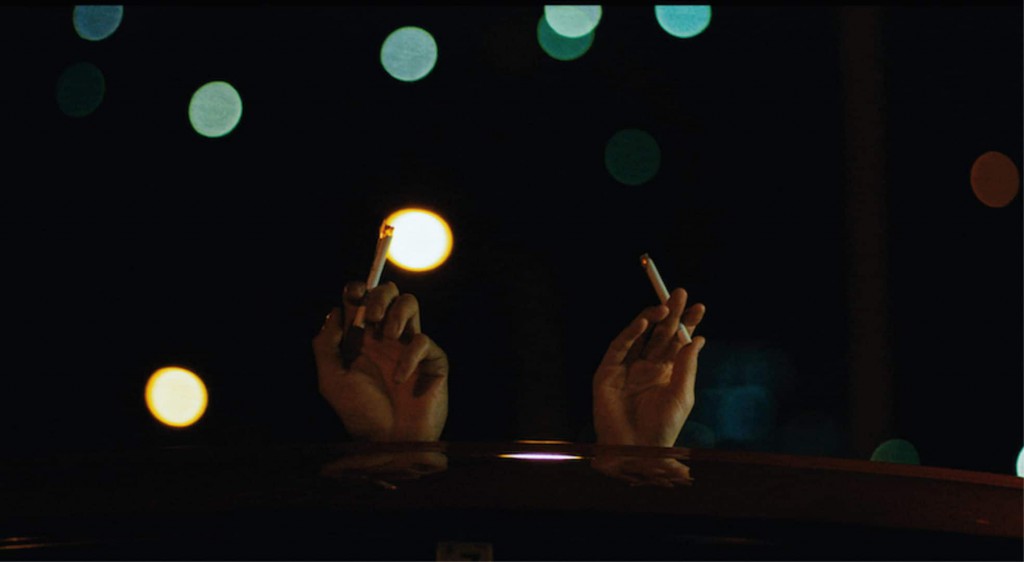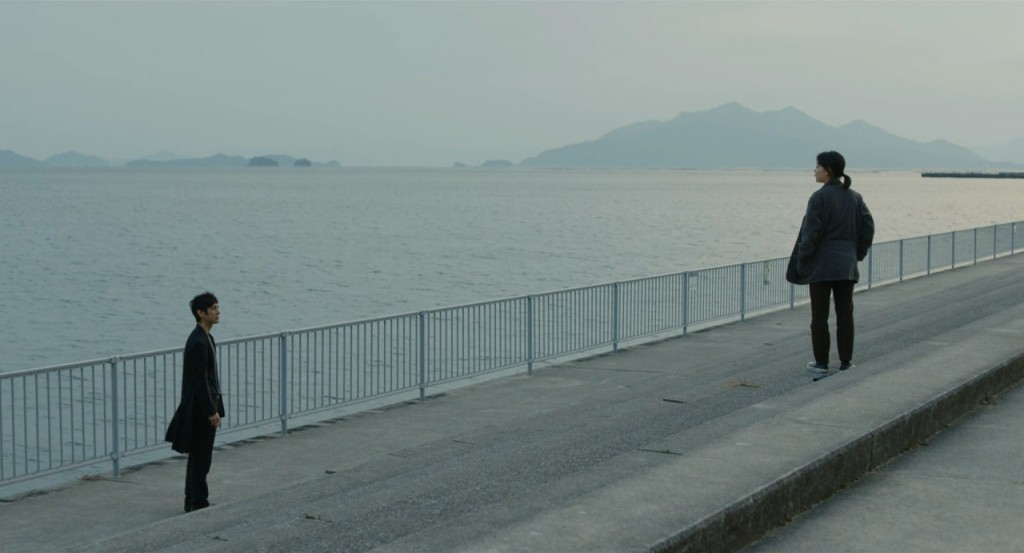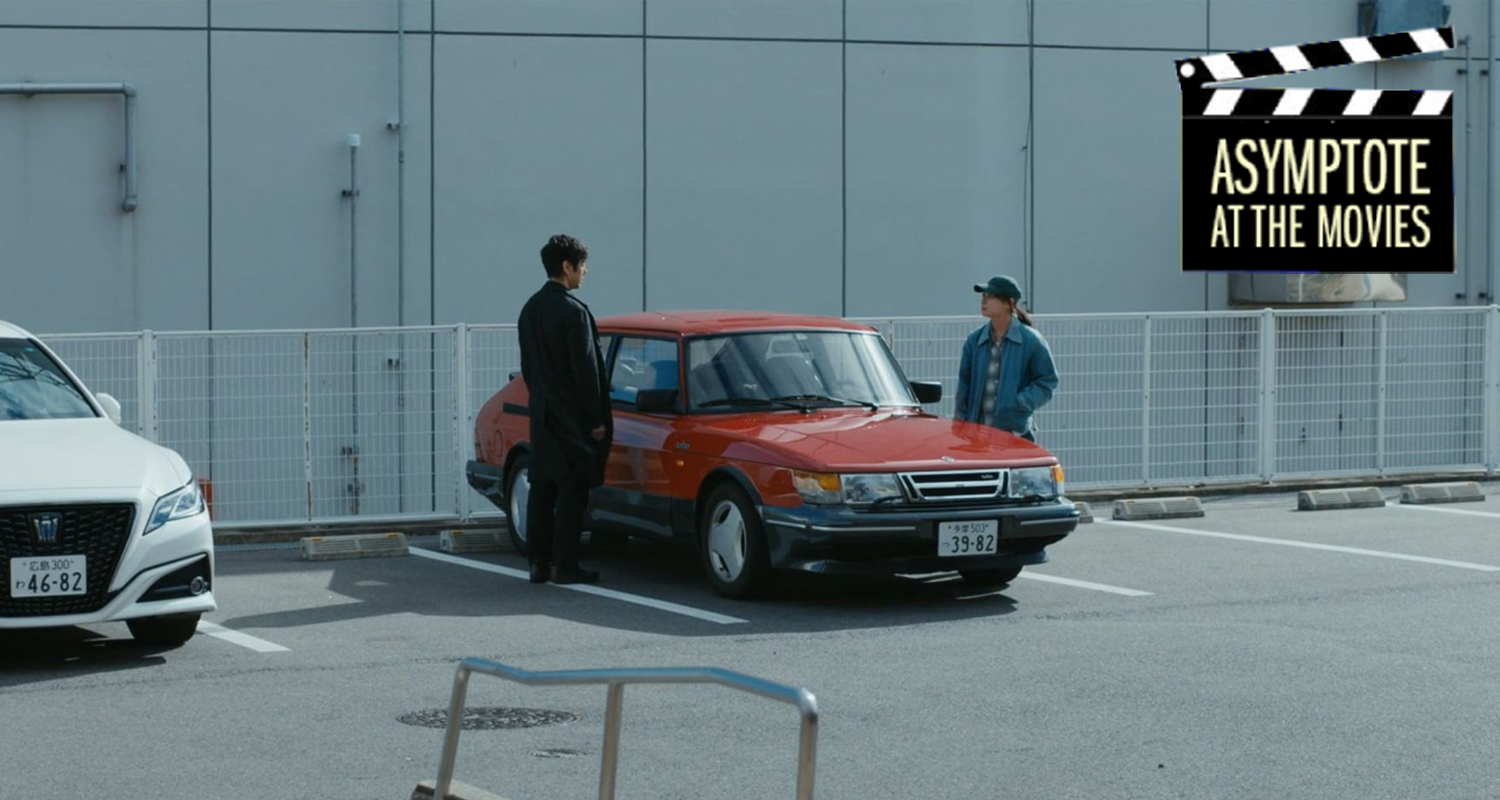There have been many cinematic adaptations of Haruki Murakami’s work, but none as successful as Ryusuke Hamaguchi widely lauded Drive My Car. In a film unafraid of language, Hamaguchi has arguably done more justice to Murakami’s paced, meditative take on simple—albeit unexpected—human relationships and connections than any director before him, and the resulting film captures that most wonderful feeling of communion between two separate works of art—when, as Hamaguchi said, “. . . as I was reading Drive My Car, I suddenly found something that clicked, something that could be done.” In the following edition of Asymptote at the Movies, our editors discuss the film and story in regards to their depictions of storytelling, friendship, and the ways we become real to one another.
David Boyd (DB): Let’s start with how the movie and the story begin. Hamaguchi opens Drive My Car with a scene borrowed from “Scheherazade,” another short story from Murakami’s Men Without Women, in which sex and storytelling are closely linked. Kafuku and Oto are shown in bed, Oto telling her husband a story that he’ll later repeat back to her. The story is pretty much the same as Scheherazade’s: a teenage girl enters the home of her crush, secretly and repeatedly, always taking something of his and leaving something of her own behind. Right away—and this seems important—we’re in a story within a story.
Murakami’s “Drive My Car” follows a very different path. In Ted Goossen’s translation, the story starts: “Based on the many times he had ridden in cars driven by women, Kafuku had reached the conclusion that most female drivers fell into one of two categories: either they were a little too aggressive or a little too timid.” At the outset, we’re entirely in Kafuku’s world, and Oto—or his nameless wife, really—has already died. Kafuku is, from the opening lines, a man without a woman.
Our connection to Kafuku changes dramatically depending on our point of entry: the bed of a married couple, or the mind of a widower with some negative thoughts about women behind the wheel.
Alan Mendoza Sosa (AMS): I was also struck by the dramatic differences between the two beginnings, and I think they have a strong impact on the public’s relationship with the characters. In the movie, we meet Oto in more depth; we become familiar with her and thus are made to feel her death more intensely than in the short story, which doesn’t really allow us to explore Oto’s subjectivity with as much autonomy—since all accounts we get of her are already filtered through Kafuku’s unreliable and misogynistic perception.
The decision to open the movie with a long set-up centered on Oto also directs our attention to the other key women in the film—Janice Chan, Misaki Watari, Kon Yoon-su, and Yuhara, all of whom, with the exception of Misaki, do not make much of an appearance in the short story. In other words, the movie’s emphasis on Oto also accents more strongly the gender relations at the center of this narrative, presenting strong and diverse—yet flawed and human—female characters, with as much psychological and existential complexity as the male ones.

Eva Wissting (EW): In Hamaguchi’s film, Kafuku appears right from the beginning as a loving husband, easy to sympathize with––even more so when we find out about his wife’s affairs. In Murakami’s short story, on the other hand, Kafuku initially comes across as a misogynist old prick, concerned with creating theories about the difference between men’s and women’s driving, all of which are so illogical that he can’t even explain them to himself without referring to a vague “charged atmosphere.” Though he applauds himself for not usually drawing distinctions between genders, his female driver’s beauty (or lack thereof) has to be commented on, both to his mechanic and to the driver herself. It’s not until later in the story, when we learn about Kafuku’s (perhaps unexpected) reaction to his wife’s infidelity, that I find something sympathetic about him. He may be judgmental in his thoughts, but in his actions, he mostly just seems lost. In Hamaguchi’s adaptation, however, Kafuku starts out as a warm and caring character, and as a creative professional, he appears stronger and more confident than his short story counterpart.
David, you mentioned the story within a story component in the film, which is interesting. I find that both versions of Drive My Car play with multiple narratives that interconnect in different ways. The film almost consists of two parts: the first being a story about Kafuku and his wife, and the second being a story about Kafuku and his driver Misaki—with the lover Takatsuki personifying a link between the two. Murakami’s work also plays with this dualism, in which I’d say the two main storylines are Kafuku being driven by Misaki between his various acting gigs, and Kafuku connecting with his new drinking buddy Takatsuki. Here, the character that links the two stories is the wife.
Speaking about stories within the story, Anton Chekhov’s Uncle Vanya plays a central role in Drive My Car. I’d be curious to hear if you have any thoughts on the significance of the play in the film versus in the short story.
DB: You’re so right, Eva. The movie has two distinct halves. The switch occurs around the forty-minute mark, when we finally get the opening credits. That has to be a record, by the way.
Uncle Vanya doesn’t show up much in Murakami’s story, does it? I think it’s mentioned maybe once or twice. In the film, Hamaguchi puts Kafuku’s multilingual production right at the center of the movie, at least after Oto’s death. Even though she’s dead, Oto’s still involved in the making of the play. Throughout the second half of the film, she’s present as a voice recorded on tape, helping Kafuku with his Vanya lines. True to her name, Oto becomes nothing but sound.
Oto’s voice in the second half of the movie reminded me of something that Mieko Kawakami said when speaking with Murakami a few years ago: that women in his stories tend to exist for the sake of male characters. They don’t really have lives of their own.
AMS: Oto’s taped voice undoubtedly gives her a stronger presence in the movie than in the story. Does she still have agency as a recorded script on repeat? It’s hard to say. But it seems that Hamaguchi presents the production of the play as, at least in part, dependent on Oto’s voice, since it is what enables Kafuku to get his lines right. So, even as a recorded message, she is still a fundamental character for the movie and, more importantly, for the world the characters live in.
David, I am intrigued by Kawakami’s observation, and I am really curious to hear what you and Eva think about the gender relations and the function of female characters in Hamaguchi’s cinematic mind. It seems that the movie does not go as far as building female characters that live only for the sake of men. Misaki, through her personal background and story, I think, strongly exemplifies a well-rounded female character undergoing her own problems, who just happened to cross paths with Kafuku. Even in the last scene, we only see Misaki apparently moving on with her life. I would even dare say that she is the most autonomous character in the movie.
EW: Thank you David for bringing Kawakami’s quote into the conversation. This is something in Murakami’s “Drive My Car”—and even more so in “Scheherazade” and some of the other stories in the collection—that left me with an ambivalent feeling. Some of the female characters appear to exist only to serve as housekeepers and listeners, or to avail the sexual pleasure of the male protagonists in a way that verges on caricature. Even if most of the main characters are male in Hamaguchi’s film, I agree with you, Alan, that the female characters are more well-rounded. As Kafuku’s driver, Misaki is certainly there to serve him, but her function as a character in the film grows into something deeper than simply what effect she has on the main character.
DB: I completely agree, Eva. While Misaki starts out as Kafuku’s driver, the relationship between the two characters changes over the course of the movie; the wall between them comes down. On some level, that wall is represented by Kafuku sitting in the back seat during their drives, as he does at first. About two hours into the movie, that changes. One night, Kafuku and Takatsuki have a long conversation in the back of the Saab. As Misaki drives the two of them around, Takatsuki completes Oto’s story—that with which the movie began. It’s a long and intense sequence, with the camera focusing on Takatsuki’s face, then Kafuku’s, then Takatsuki’s again. While Misaki’s there in the car with them, driving and listening, she doesn’t appear on screen. When Takatsuki finally gets out of the car, Kafuku moves up front. I’m pretty sure he never sits in the back again. From that point on, Misaki and Kafuku seem to share a different kind of relationship. That’s also when we get that really beautiful scene with the two of them smoking in the Saab, holding their cigarettes up over the top of the car as they drive. I don’t know about you two, but I really like that shot.

AMS: I really enjoyed that shot between the two men as well. It also reminded me of Susan Stryker’s idea of homosocial desire, which highlights the homoerotic dynamics behind straight male relationships, where talking about women—often misogynistically—becomes a way of sublimating their repressed homosexual desires. I thought of this concept because Kafuku and Takatsuki become progressively more intimate, allowing each to see the other’s vulnerability. I wouldn’t go as far as to say that the director is criticizing male heterosexuality, but I do think he is exploring the limits of traditional masculinity from one of its main pillars: heterosexual love. It seems that the sorrow that Kafuku and Takatsuki feel for Oto’s death is, at the same time, a vehicle for their repressed emotional expression—primarily reserved, as the movie makes clear, to the domestic sphere. Both Kafuku and Takatsuki are actors, and perhaps they have played their masculine roles so well and for so long that only a devastating tragedy such as Oto’s death can shake them from those parts.
EW: I agree, that shot with Kafuku and Misaki smoking in the car is wonderful, and the preceding dialogue between Kafuku and Takatsuki is intense. There is no doubt that the two men are drawn to each other. In the film, Takatsuki seeks out Kafuku to audition for a role in his play, and later asks Kafuku to join him for a drink, wanting to get close to him. During most of their interactions, Kafuku keeps a certain distance, but nevertheless he gives Takatsuki the role, and he also agrees to have a drink. During that dialogue in the car, for the first time, Kafuku appears to let his guard down, to talk about something personal, telling Takatsuki about Oto’s stories. At that very moment, however, he realizes that maybe Takatsuki knows more than he himself does, and the power dynamics are changed between the two. It’s interesting that right after this, Kafuku moves to the front of the car.
Misaki and Kafuku both have the car as their safe space. Misaki says that driving is the only thing she has ever been good at, and it was through driving that she was able to leave her old life and build a new one. For Kafuku, his Saab has been his special gem for a long time, but after the passing of Oto, the car has also been a place where he connects with his late wife through the cassettes. After rewatching Drive My Car, I think maybe the film is more about friendship than about loss, or romance, or about anything else.
DB: That makes a lot of sense to me. At the same time, Hamaguchi’s adaptation goes out of its way to make sure we feel the full impact of Kafuku’s loss. I really wouldn’t like the idea of this movie without the first forty minutes—because Kafuku’s time with Oto means so much to the film as a whole.
Couldn’t we say that Hamaguchi’s Drive My Car is largely about letting go? In the end, Kafuku moves on, doesn’t he? While the Saab certainly serves as a safe space for some time, eventually he needs to hand the keys over to Misaki. As we’ve been saying, the car’s clearly connected to Kafuku’s past, to his life with Oto. He couldn’t move on without surrendering the Saab.
Of course, Murakami’s story doesn’t take us that far. The film moves beyond its source material. Then again, according to Hamaguchi, when Murakami saw the movie, the writer said he didn’t know which parts were his own and which were Hamaguchi’s. In other words, to Murakami, the film felt like a faithful representation of his writing. At least I think that’s what he was saying… If that is in fact what Murakami meant, I’m inclined to agree.
AMS: I like the observation that the film goes beyond Murakami’s story; the movie stands on its own as a fully-developed piece of art. The fact that Hamaguchi did not hold back on adding additional moments, such as the long portion when we see Kafuku and Oto, shows that the success of a cinematic adaptation rests less upon its ability to closely imitate the original story and has more to do with how it uses the visual format to add to the story being told. For instance, whereas the story, so heavily focalized on Kafuku, makes me feel claustrophobic, the movie has a more hopeful tone because of the cinematic decisions that Hamaguchi made, such as including the long portion with Oto, adding an extended focus on Misaki, and presenting an abundance of landscapes and day-scenes. If the way the story is presented as a film makes it about the possibility of letting go, I feel that the written story, in Murakami’s version, is more about being stuck in the past and the tragic impossibility of overcoming loss. In other words, I was fascinated by how the different formats—movie and literary text—combined with the visions of their creators, can directly change the meaning of the same story.

EW: Letting go is a major theme in the film—and more so in the film than in the short story. In the end, I think for both Kafuku and Misaki, their friendship (if friendship is the right term for the connection they develop with each other) is what eventually enables them both to let go of their different pasts and move on. It’s so interesting what you mention, David, that Murakami didn’t know which parts of the film were from his story and which were added by Hamaguchi, even though the film clearly differs from the short story in multiple ways. I think a good story works like that: it can transform in different formats and even relate something new back to its original creator.
David Boyd teaches translation at the University of North Carolina at Charlotte. He has translated stories and essays by Mieko Kawakami, Hiroko Oyamada, and Izumi Suzuki, among others.
Alan Mendoza Sosa holds a BA degree in Comparative Literature in English and Spanish from Brown University, and an MPhil in Latin American Cultural Studies and Comparative Literature from The University of Cambridge. He is an incoming student at Yale University’s PhD in Spanish and Portuguese. He is interested in eighteenth century Hispanic Culture, the Latin American Avant-Gardes, Postcolonial Theory, Queer Studies, and Contemporary Hispanic Literature.
Eva Wissting is a writer, editor and translator with a BA in English literature and creative writing from University of Toronto and an MA in English from York University. Her writing has been published in Kritiker, Horisont, Populär Poesi, and elsewhere.
*****
Read more on the Asymptote blog:

